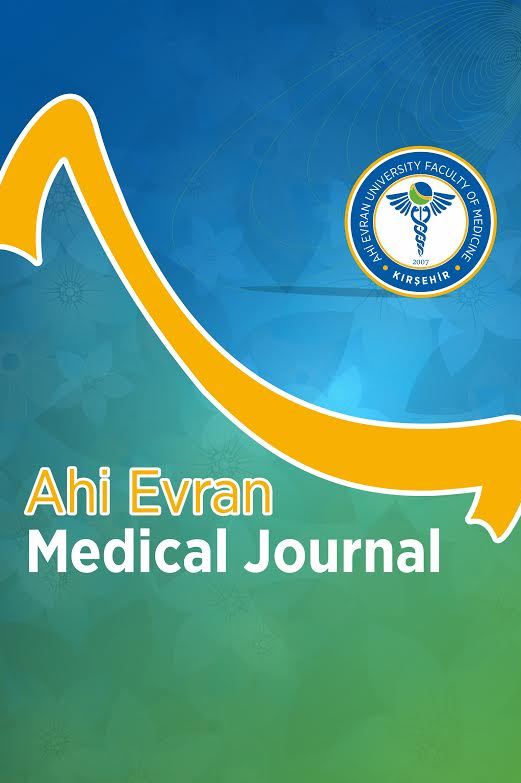Kemiksiz Çekiç Parmağın Splintleme ve Perkütan Pinleme Tedavileri: Retrospektif Klinik Çalışma
crawford kriterleri;, eğimli tokmak;, kirschner telleri, uzatma splintleme
Splinting and Percutaneous Pinning Treatments of Non-Bony Mallet Finger: A Retrospective Clinical Trial
___
- 1. McCue FC, Meister K. Common sports hand injuries. Sports Med. 1993;15(4):281-289.
- 2. Bloom JM, Khouri JS, Hammert WC. Current concepts in the evaluation and treatment of mallet finger injury. Plast Reconstr Surg. 2013;132(4):560e-566e.
- 3. Jm A. Splint For Mallet-Finger. Br Med J. 1965;1(5432):444-444.
- 4. Vernet P, Igeta Y, Facca S, Toader H, Diaz JJH, Liverneaux P. Treatment of tendinous mallet fingers using a Stack splint versus a dorsal glued splint. Eur J Orthop Surg Traumatol. 2019;29(3):591-596.
- 5. Crawford GP. The molded polythene splint for mallet finger deformities. J Hand Surg Am. 1984;9(2):231-237.
- 6. Warren R, Norris S, Ferguson D. Mallet finger: a trial of two splints. J Hand Surg Am. 1988;13(2):151-153.
- 7. Kinninmonth A, Holburn F. A comparative controlled trial of a new perforated splint and a traditional splint in the treatment of mallet finger. J Hand Surg Am. 1986;11(2):261-262.
- 8. Altan E, Alp NB, Baser R, Yalçın L. Soft-tissue mallet injuries: a comparison of early and delayed treatment. J Hand Surg Am. 2014;39(10):1982-1985.
- 9. Hong IT, Baek E, Ha C, Han S-H. Long-term Stack splint immobilization for closed tendinous Mallet Finger. Handchirurgie· Mikrochirurgie· Plastische Chirurgie. 2020;52(3):170-175.
- 10. Fritz D, Lutz M, Arora R, Gabl M, Wambacher M, Pechlaner S. Delayed single Kirschner wire compression technique for mallet fracture. J Hand Surg Am. 2005;30(2):180-184.
- 11. Han HH, Cho HJ, Kim SY, Oh DY. Extension block and direct pinning methods for mallet fracture: A comparative study. Arch. Plast. Surg. 2018;45(4):351.
- 12. Geyman JP, Fink K, Sullivan SD. Conservative versus surgical treatment of mallet finger: a pooled quantitative literature evaluation. J Am Board Fam Pract. 1998;11(5):382-390.
- 13. Stern PJ, Kastrup JJ. Complications and prognosis of treatment of mallet finger. J Hand Surg Am. 1988;13(3):329-334.
- Yayın Aralığı: Yılda 3 Sayı
- Başlangıç: 2017
- Yayıncı: Kırşehir Ahi Evran Üniversitesi
Pandemi Sürecinde Çocukluk Çağı Ev Kazalarının Basın Haberlerine Yansıması
Seda DEMİRCİ, Asya Banu BABAOĞLU
Merve GÜRSOY DEMİR, Can ÖNER, Huseyin CETİN, Engin Ersin ŞİMŞEK
Hemorajik İnmeli Hastalarda Homosistein Düzeyleri
Aysu YETİŞ, Asuman ÇELİKBİLEK, Aysel KAYA TEKEŞİN, Orhan YAĞIZ
Kemiksiz Çekiç Parmağın Splintleme ve Perkütan Pinleme Tedavileri: Retrospektif Klinik Çalışma
Selami KARADENİZ, Alparslan YURTBAY
Ayak Bileğinde Gelişen Tenosinovyal Dev Hücreli Tümör: Nadir Yerleşimli Olgu Sunumu
Hatice KAPLANOĞLU, Veysel KAPLANOĞLU, Aynur TURAN, Rasime Pelin KAVAK, Tuba AKDAĞ
COVID-19 Hastalarında Antioksidanların ve Oksidatif Hasarın Durumu
İrfan BİNİCİ, Hamit Hakan ALP, Zübeyir HUYUT, Esra GÜRBÜZ, Hülya GÜNBATAR, Şükrü AKMEŞE, Mustafa Kasım KARAHOCAGİL, Halil İbrahim AKBAY
Hasta Beklentileri Memnuniyet ve Fonksiyonel Sonuçlarını Etkiler Mi?: Sistematik Derleme
Üçüncü Basamak Sağlık Kuruluşuna Başvuran Hastalarda COVID-19 Serolojisinin İncelenmesi
Pelin ONARER, Tuğçe ÜNALAN-ALTINTOP, Fikriye MİLLETLİ SEZGİN
